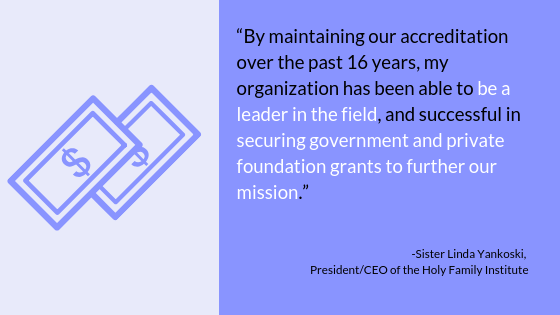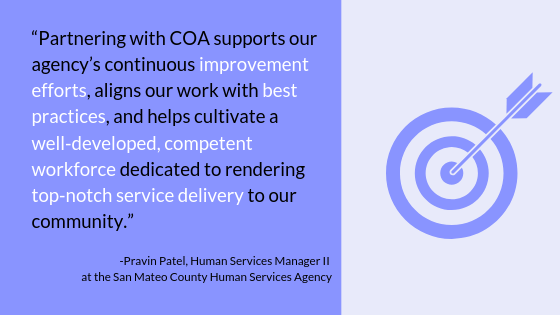February 1, 2022 @ 3:00 pm – 3:30 pm EST
This free 30-minute webinar provides an introduction to Social Current and COA Accreditation. It is perfect for anyone seeking accreditation for the first time, interested in what is required to become accredited, or mandated to become accredited by state or federal legislation.
Participants will gain an understanding of the key concepts that define COA Accreditation, the steps toward becoming accredited, and the benefits of accreditation. There will also be a Q&A portion for us to answer any questions you might have.
Presenter

Joe Perrow
Network Growth Manager
Social Current
Related Events
February 28, 2022 @ 1:30 pm – 4:30 pm EST
This training is full. Register for another 2022 session.
The Intensive Accreditation Training (IAT) is designed to prepare organizations to get the most out of their COA Accreditation experience. Topics discussed in this training include:
- An in-depth overview of the COA Accreditation process, including key milestones
- An overview of accreditation standards and the relationship between standards, evidence, and the rating indicators
- How ratings are assigned by the volunteer review team and insight on the accreditation decision-making process
- Tips on how to get organized and manage the work
- How to prepare for the site visit
COA Accreditation is offered as a service of Social Current. Learn more about COA Accreditation and how to get started online.
2022 Intensive Accreditation Trainings
This training will be offered six times in 2022. Register now for any session:
Who Should Participate
- Organization primary contacts
- Senior leaders at organizations seeking COA Accreditation
- Other staff involved in an organization’s accreditation process
Related Events
In response to the COVID-19 pandemic, COA made adaptations to the Site Visit, a foundational part of the accreditation review. Incorporating feedback from our volunteers and organizations, the new virtual review options both allow organizations to move forward with completing their accreditation requirements and prioritize the safety and health of our Volunteers, organizations, and the individuals they serve, all while maintaining the integrity and rigor of our accreditation process. The virtual review is fundamentally designed to minimize in-person interaction amid the pandemic. Conducting interviews and reviewing onsite documents/evidence is completed remotely, through the use of HIPAA-compliant secure environment. When an in-person walkthrough of the organization is needed, assignment of local volunteers is prioritized to minimize travel (and any related concern(s)), and safety guidelines are stressed and followed.
As the pandemic continues to challenge all facets of our lives, we are tested to think differently, creatively, and with flexibility to accommodate for these unpredictable times. The move to virtual reviews required a quick turnaround from planning to implementation, and the continual feedback we have received has helped to refine the process. As a result, COA has increased different ways of communicating expectations and providing support, such as developing a checklist to clarify steps of the virtual review, establishing monthly meetings with leads of the review team, and hosting webinars on virtual reviews for organizations and Volunteers.
The collaboration between Volunteers and organizations has been instrumental in the successful implementation of the virtual review. We are pleased to relay reflections from a Volunteer for COA as she experienced her first virtual review!
COA – The virtual way
As I embarked on my July 2020 COA Zoom Site Visit journey as Team Leader, I questioned whether this was going to be the next future reality. I wondered if this was something I was comfortable doing and whether the integrity of the accreditation process was being compromised.
Also I thought…
What happened to the travel and enjoying new places? Good food? Spending time with colleagues? Meeting new people? Witnessing organizations taking care of those in their communities? Developing new programs? Learning and growing?
Retiring and giving back to the field was not supposed to be “virtual” – or was it?
We began with a team of four, and none of us had met or worked together (which make me think “great- now I have to juggle three new personalities as well as agency folks!”). We also covered a large portion of time zones, from Hawaii to mainland central time. “Oy vey!”
The team turned out to be one of the best I have ever worked with: a caring, dedicated group of professionals that were knowledgeable, patient, and flexible. We were not the most techie group, but thanks to the help of COA’s IT staff, we all figured it out.
I began with contacting the POC, using my social work skills to convince her that we knew what we were doing and everything would go smoothly. We started with a team Zoom meeting a few weeks before the review. We invited the agency POC to join the Zoom meeting so everyone could become acquainted, ask questions, and feel comfortable. It was decided that each Peer would set up their own schedule with the POC, with me only having to decide on the Entrance, Pre-Exit, Exit, and team meetings and my own schedule. Wow…it worked fantastic; everyone was happy! We decided to have a dedicated person assigned to each Peer that would be their “go-to” for all aspects of the review. (I secretly prayed that no one would drop off this review as I was beginning to feel some anxiety – I was worried it was going too well to be true!). We all began working at least week ahead of the actual date for the review, reviewing the Box, conducting interviews, going on virtual ASE facility tours, and working out IT bugs. We developed a back up plan with a conference number in case of any Zoom failure.
After numerous phone calls and emails, we had our team Zoom Sunday night to touch base before the Entrance Meeting. Everyone scheduled their Zooms with POC, and she did the invites from there. Easy!
Ready, set, g… no. One Peer couldn’t get Zoom fully working – maybe they would have it ready by the a.m.
Monday morning, all four Peer Reviewers were visible, and there were over 30 in attendance at the Entrance. We did the usual introductions, covered the COA process, and asked the agency CEO to give us some background and history of the organization. It was well done, and made up for some of the missed onsite interaction. The POC did an incredible job facilitating the whole process.
Zooms happened all day long without a glitch. Agency staff made sure the connections and introductions happened, and then dropped off the Zoom meeting.
Review of records and screen sharing went well, although we were not able to review as many records as we usually do. Meetings started and ended on time. Very few schedule changes were needed.
We added an additional Peer on the fly to agency to review the crisis center. No standards or ratings were assigned to her. She was just in and out and sent me a report – thank you! – which was wonderful.
Tuesday was the same. Very organized. Wednesday we Zoomed with team again before exit. We were all pretty Zoomed out and ready to be done. For the Exit Meeting, we had 76 in attendance on Zoom! Awesome!
The team did a wonderful job presenting on their standards, experiences, and sharing strengths with agency. By now it made no difference whether we were on-site or virtual. We were all connected, and the emotional impact that is often felt on site was present. The Peers presented with passion and professionalism. The CEO was grateful for the experience.
Although I, like most of my peers, am anxious to travel and be present with agencies, the COA staff have done an outstanding job figuring out how to get this done with integrity, best practices still in place, and camaraderie. Thanks!Oh, and the dietary question… the agency did send us all delicious cookies to enjoy at our home desks while working. A working snack – much appreciated. Thank you.
So my friends, “Zoom on” until it’s safe!
-Maddi Noleen, COA Peer Review Volunteer
Have questions about the virtual review process? Reach out to your Accreditation Coordinator, or contact us here.
In 2016, COA began our 2020 strategic planning process. We talked with and surveyed our network on their reasons for seeking COA accreditation and how we could provide even more value to their experience. One recurring theme was the need for data. Our organizations employ sophisticated quality improvement systems to manage their success, but respondents noted a lack of quality external benchmark data to complement their internal data.
History
COA’s pilot benchmarking program launched in the summer of 2016 as part of COA’s Maintenance of Accreditation (MOA) process. It was based on two years of research and replaced our old, narrative-driven MOA process. In the old process, organizations would write an extensive overview of their PQI activities in the past 12 months, and COA would review these narratives and provide feedback. It was a time- and resource-intensive process, and at the end of the day provided little value to COA or our accredited organizations.
We wanted to create a system which had 360-degree value for our network, and this idea was the genesis of the pilot benchmarking program. By collecting, aggregating, and sharing data, we created a system which provided value to all parties:
- COA can better understand our network;
- Organizations are monitoring basic key performance indicators to understand their performance; and
- Our network, as a whole, is enriched with comparative benchmark data.
We started with five measures of organizational health and sustainability: days cash on hand, staff retention rate, management retention rate, average staff tenure, and rate of substantiated grievances. Organizations resoundingly preferred this system and, based on feedback from our network, it surfaced again and again as a priority for us during our strategic planning process for 2020. Based on feedback from our network, we’re enhancing this system to collect and share back even more benchmark performance data.
Goals
We had three primary goals for refining our benchmarking program:
- Universal measures: COA accredits over 60 services and works with a plethora of organizations within the human and social services space. When selecting new measures for this program, we stuck with measures of organization health and sustainability because these are applicable to human and social service organizations of any size or purpose.
- Unlike any other benchmarking services available to our network: we knew we needed a unique benchmarking program which provided:
- Multifaceted measures which gave a holistic view of an organization’s performance
- Segmentation logic. Much of the benchmark data available to our sector is not specific to human and social service organizations. Many times, data is collected from all tax-exempt entities. But, it’s just not valuable for our network to be compared to animal welfare organizations, arts nonprofits, and similar entities. Our program is focused solely on human and social service organizations. In addition, we’re using all of our data to create very narrow segments or clusters of organization for even more valuable comparisons. In future iterations, we hope to roll out custom segmentation for our end-users.
- Improved data collection methodology: as a part of the new MOA process, we’re collecting benchmark data from our network annually and associating it with a discrete fiscal year. This ensures we have a consistent and reliable flow of data to share back with our network.
New Benchmarking Program
Starting in 2020, all organizations accredited under COA’s Private and Canadian organization accreditation will provide data via an Annual Report. This report is due 60 days after the start of your fiscal year and collects data on your prior fiscal year. It is part of our Maintenance of Accreditation process, and organizations must complete this report to maintain their accredited status. Here’s how the process will work:
- COA will notify your organization’s primary contact 60 days before the Annual Report is due. This should land around the first day of your new fiscal year.
- Once this notification is received, organizations can access their Annual Report cycle via their MyCOA Portal.
- The MyCOA Portal has step-by-step instructions for gathering and inputting the requested data.
Step-by-step guide to completing the Annual Report
Around the start of your fiscal year, your organization’s primary contact will receive an email inviting you to complete your Annual Report. It will list the due date and steps for completing the report.

Next, log in to your MyCOA Portal. Use the Pick a Cycle link to navigate to the correct cycle. In this example, the organization’s Annual Report is currently due. In addition, the organization has 2 Maintenance Fee cycles in 2020 and 2021; for these cycles, only the Maintenance Fee is due. To complete the Annual Report, select “2020 Annual Report.”
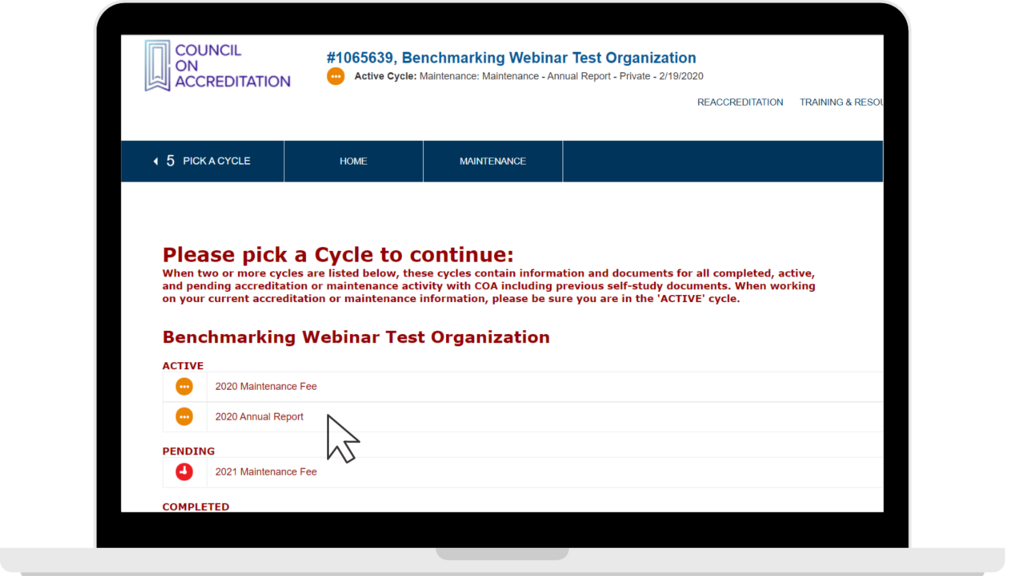
On this page, the timeline will show when the Annual Report is due – in this case, on 12/31/2020. Select “Continue.”
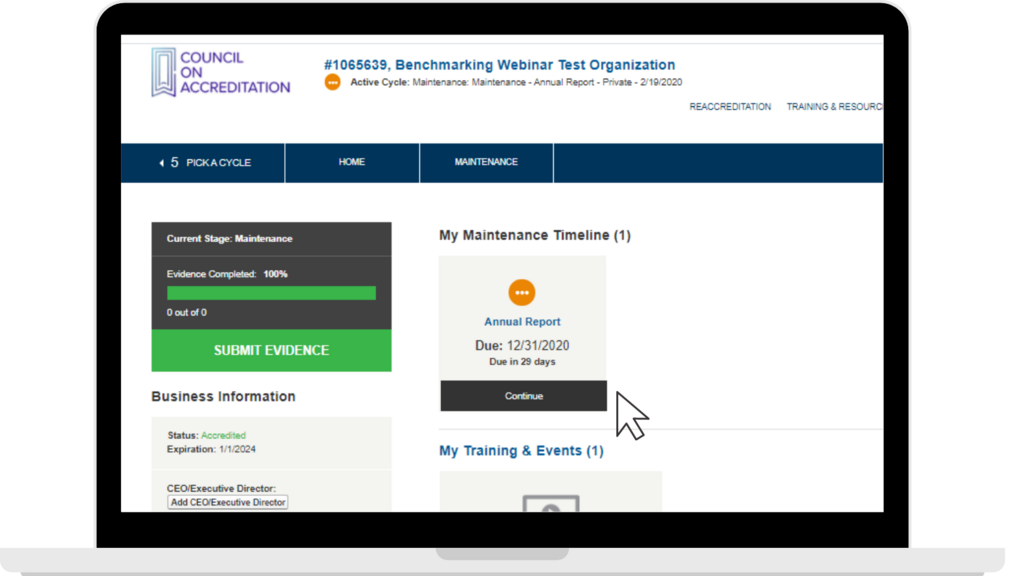
This page gives a step-by-step overview of how to complete the Annual Report.
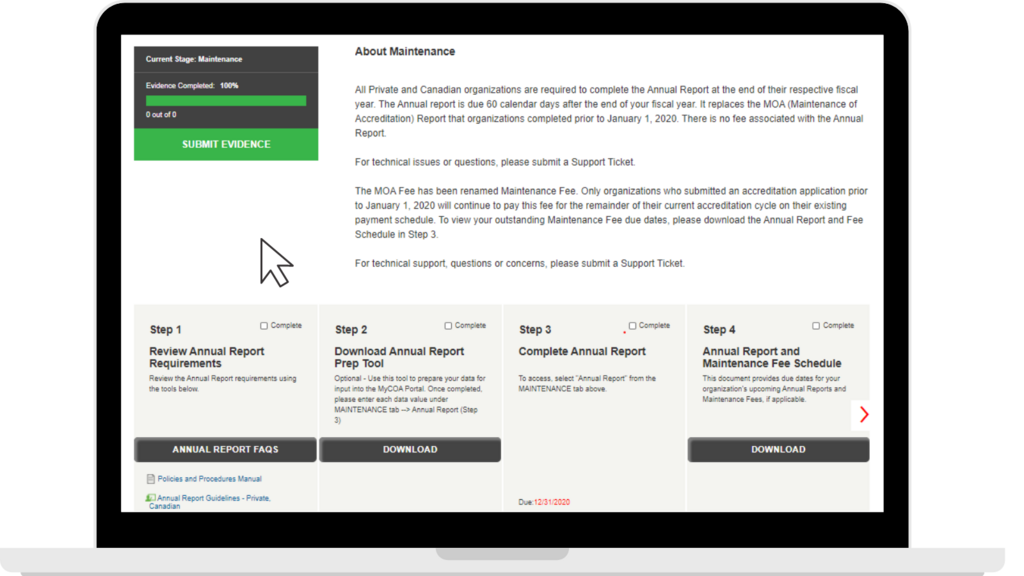
Step 1
If you’d like, you can review the Annual Report requirements and FAQs using the links in Step 1.
Step 2
COA understands that, oftentimes, only one or two staff have access to the MyCOA Portal. So, we created the Annual Report Prep Tool to help you gather your data before inputting it into the MyCOA Portal. Click the DOWNLOAD button in step 2; COA will merge any data we may already have into this document so you’re not doing duplicative work. Share the Prep Tool with relevant staff to gather your data. Please note the completion of the Prep Tool is optional. The Prep Tool is for internal records only and does not need to be submitted to COA.
Step 3
In order to complete the Annual Report, all data must be submitted electronically in your MyCOA portal. Hover over the MAINTENANCE tab in the top toolbar, and select “Annual Report from the dropdown menu.

This will open the Annual Report electronic submission form.

If you used the Prep Tool, copy the information from the Prep Tool into this form. You’ll notice that the questions are in the exact same order as in the Prep Tool. You can save at any time by click the “Save my progress and resume later” checkbox in the top right corner and then the Save button.
Once all information is entered, click the Submit button at the bottom of the form.
On the following page, confirm the accuracy of your data. Then, click Confirm to fully submit your data. At this point, you can also select “Print this page” to print a copy of your report for your records.

Once the data is submitted, the card on your Milestone Timeline will indicate the completion date and you are done with your submission! Please note: If you would like to make any changes to your submission, please submit a Support Ticket in the MyCOA portal.

The Benchmark Report – available Q1 2021
Once COA receives all data from accredited organizations for a particular fiscal year, we’ll unlock the benchmark report and allow you to access it from within your MyCOA Portal. Download a sample benchmark report here.
Segmentation Logic
The benchmark report uses segmentation logic to create a comparison group of organizations like yours; we then use this group to calculate your benchmark figures. We use data on your business type (nonprofit or for–profit), services provided, revenue, and geographic location to construct this group and ensure an apples-to-apples comparison. We want to provide you with data which has the utmost “comparison integrity” so you can be confident the benchmarks are meaningful to you.

The cover page indicates the fiscal year to which the report pertains, describes the group of organizations against which your organization is compared, and lists the publication date – the date on which the report was generated.
The characteristics of your organization are used to generate the comparison group. The sample organization receiving this report is a nonprofit organization accredited under COA’s Private Organization Accreditation program and provides foster care services with a revenue between $5-10M. When generating your benchmark data, then, we pulled data only from organizations which fit these characteristics. This ensures the comparisons made in this document are valuable to the sample organization.
The following pages organize all benchmark metrics into their domains. First, we have the FINANCIAL HEALTH BENCHMARKS: each metric is given a title, a description of what it is and why it is important, and a chart comparing the sample organization’s data to the average value of its comparison group. In this top metric, Months of Liquid Unrestricted Net Assets or LUNA, the sample organization and its comparison group had 6 months of LUNA, so the sample organization can be confident that its liquidity – as measured by LUNA – is within normal range for their type of organization.
Each subsequent page lists measures belonging to a particular performance domain, and follows the same structure: title, description, and a chart comparing your data against your comparison group.
Scrolling down, the ADDITIONAL DATA page shows all of the sample organization’s data and the comparison figures in one view. We also provide the Percent Rank for each metric. The Percent Rank locates your organization within the comparison dataset. For example, the sample organization’s Months of Liquid Unrestricted Net Assets has a percent rank of 33.3%. This means that the organization’s Months of LUNA was higher than a third of organizations but lower than two-thirds of organizations in the comparison dataset. Percent rank is just another way of showing you how you compare to similar organizations.
The final page lists some FAQs. As your questions come in, we’ll update this page with more information for reading and understanding your benchmark report.
Additional information
We have created a custom website with further information about COA’s benchmarking program at www.coameasures.org.
If you missed our benchmarking webinars, please feel free to view the recording here.
If you have any further questions about changes to the maintenance of accreditation process, please feel free to contact Ingrid Zamudio, Data Science Manager. For questions specific to your organization, please submit a support ticket in your MyCOA portal.
So, you’ve been designated by your organization as the Primary Contact—the point person for communicating with the Council on Accreditation (COA) and spearheading the accreditation process. Maybe you’re feeling a little overwhelmed; you might not be sure about the best way to get the job done. Fear not! We’re here to help with tips on how to make the process as smooth as possible, whether this is your first time managing the accreditation process or your fifth.
1) Get organized

If we were to create a job description for the Primary Contact role, strong organizational skills would be first on the list of required traits. You need to be able to organize, prioritize, and project manage. This includes assessing the scope of the work, identifying available/necessary resources, and planning for the completion of tasks while working towards deadlines.
There are a lot of moving parts during the accreditation process, so it is critical to stay on top of due dates and important notifications from COA. You also need to make sure that these are communicated within your organization, and that you clearly outline expectations regarding the workload and workplan for other staff to maintain efficiency.
Sound like a lot? Don’t worry! We have some resources that can help those efforts. Here are a few to get you started:
- SELF-PACED TRAINING: Getting Organized/Creating a WorkplanThis self-paced training provides guidance on coordinating and managing the work of the self-study process, with the goal of developing a comprehensive accreditation work plan.
- BLOG POST: Roadmap to Preparing for the Accreditation Process Another handy, step-by-step guide to help you get a handle on the various tasks involved with accreditation.
- BLOG POST: Creating Effective Workgroups on the Road to AccreditationGet tips on how to organize and delegate work to different staff.
- MYCOA PORTAL: Your Standards and Self-Study StepsWe built the MyCOA Portal with the goal of setting you up for success. The Standards & Self-Study tab (option five in the blue navigation bar at the top of the screen) is one good example of this: it features a checklist of steps to complete during the Self-Study process; a progress bar to help you track how you’re doing; and links to important documents to help you along the way.
2) Communicate clearly and often

The accreditation process centers around good internal and external communication.
From an external standpoint, as the Primary Contact you are responsible for overseeing all communications between your organization and COA. Whether it is over the phone or email, it is essential to keep your Accreditation Coordinator in the loop about any significant program updates or organizational changes.
From an internal standpoint, it is important to have staff, management, and your governing body appropriately informed of the process. This will not only help everyone work together to get things done, but also ensure that accreditation’s benefits are felt organization-wide.
Pro tip: Maximize your relationship with your Accreditation Coordinator
COA partners with organizations throughout the accreditation process. A key component of that partnership is the relationship between the Accreditation Coordinator and you, the Primary Contact. Here are a few suggestions on how to capitalize on this unique benefit.
- Schedule – and really use to your advantage! – a monthly call, especially if it’s your first time going through the process. Having the time carved out on your calendar ensures that you have time specifically dedicated to accreditation each month. (Ex: “I have my call with my Coordinator next week and I haven’t looked at the FPS standards yet – let me get on that now!”) We understand that everyone has a million things going on in addition to accreditation, so blocking off time for checking in and asking questions is one way to stay on top of things.
- Check out our extensive accreditation resources first before bringing any additional/clarifying questions onto your call. This will make sure that you’re using your time with your Accreditation Coordinator as productively as possible.
- Involve other staff members in the monthly calls. Not only can this be a more efficient way to get everyone on the same page, but it also makes the process more team-driven and rewarding. This allows other staff members to “get to know” the COA voice on the other end of the phone to experience the partnership firsthand.
- Whether for scheduled calls or when staying in contact in general, it is helpful for Accreditation Coordinators when Primary Contacts gather and send questions all at once, especially very specific standards questions. This is particularly beneficial when it comes to monthly check-in calls. If questions are sent over (in one email) a few days before the call, it gives the Accreditation Coordinator time to prepare and touch base with their team/the Standards Development Department as needed, which maximizes your time and makes for a productive conversation.
3) Be transparent

Transparency is another critical factor to your success as a Primary Contact. This goes hand in hand with being a good communicator.
We often say that the Self-Study process is like holding a mirror up to your organization. This works best for everyone when the mirror is a clear one! Your Accreditation Coordinator is there to provide technical assistance and targeted support, but they can only do so if you communicate honestly about your struggles so that they can help you navigate your pain points. Identify your organization’s needs and be eager to ask questions.
This advice applies when communicating within your organization as well. Often, we find that one staff member doesn’t always hold all the knowledge/documents that are necessary to complete the accreditation process; therefore, it is important that you approach other staff and pull them in as a resource when needed.
4) Get involved

We’ve already highlighted the importance of working with your Accreditation Coordinator – they are there to answer questions, interpret the standards, and guide you through the process. But don’t forget about all our other resources that are there for you to tap into!
If it’s feasible time- and budget-wise, attending our live Intensive Accreditation and Performance and Quality Improvement trainings can be very impactful, particularly if you or your organization are new to the accreditation process. We hold these trainings a few times a year. They are a great resource not only for taking a deeper dive into managing accreditation and learning strategies to enhance your PQI system, but also for networking with (and learning from!) colleagues that are in the same boat as you. Attending these is not a prerequisite for being a stellar Primary Contact, of course, but they are helpful if you can make it to them.
COA also has a plethora of self-paced trainings, tip sheets, tool kits, and more. Your MyCOA Portal will offer suggestions of which of these will work best for you at different points in the accreditation process. Be sure to use it! You will find everything that you need there to successfully navigate the process. The portal is secure, customized and will always include the specific information that is relevant to your organization.
Digging into these resources will provide you with a good overview of 1) how COA is going to review your organization, and 2) all the major milestones you need to hit along the way. This will help you to grasp the amount of work needed and the different deadlines that your organization is going to approach. Knowing these will help you guide others in your organization toward success.
Pro tip: Find your tribe
COA lists all our accredited organizations on our public website. Use the Who is Accredited Search to find peer organizations by location or service area. This practice can help you create a network and empower you and other Primary Contacts to access resources, share information, and ultimately make the most out of the accreditation process.
5) Be an accreditation cheerleader

Getting through the accreditation process is all about creating and maintaining momentum with your team. COA’s review is very comprehensive, and so it includes many potential ways for different staff to participate. Establishing and championing those opportunities can contribute to making accreditation more fun, rewarding, and successful.
We encourage Primary Contacts to tap into their creative side. Try developing a game that incorporates COA’s accreditation standards or creating a fun visual that tracks your progress. Your job is all about being a good motivator, so celebrate the victories both big and small. With as hard as you’re working, you all deserve it!
Though being a Primary Contact can feel like a lot of responsibility, rest assured that accreditation is by no means a one-person job. The process–from pulling together Self-Study evidence to preparing for the Site Visit–should be a team effort. Your role, then, is of a team captain. With these tips, we hope you can get out there and lead your crew to success!
Further reading
If you want to do a deeper dive, we’ve pulled together some additional resources below. Don’t forget to also check out those linked directly in your MyCOA portal.
- Accreditation Learning Plan
- Preliminary Self-Study Fact Sheet
- Three-Part PQI Recorded Webinar Series
- PQI Tool Kit
- Intro to Logic Models
- Governance Standards Tool Kit
- Policies and Procedures Checklist
- Preparing for the Site Visit
Watch a special message from Jody Levison-Johnson, COA’s new President & CEO, and then read on below to hear more about her thoughts on what’s next for COA.
TRANSCRIPT
Hi. I’m Jody Levison-Johnson, the new president and CEO of the Council on Accreditation, or as some in the field like to call us, “COA (Kō-Ah).” I wanted to take a few moments to introduce myself and share a bit about the future of COA.
My background includes work in direct service organizations, oversight and funding entities, and national policy and advocacy arenas. Leading COA is the realization of my lifelong dream to shape the human services field and profoundly impact the lives of the people in need.
And the timing of my arrival here could not have been better.
This is truly an exciting time at COA. We are changing the field by helping organizations offer services of the highest possible quality to their clients and their communities.
For a long time and for many people, accreditation has just been another box to check, a means to an end to ensure eligibility for funding streams or to meet regulatory requirements. But it is so much more than that.
We hope to elevate–both within COA and among our accredited organizations–the true value of accreditation. That value is to the end user, the consumers—the children, youth, families and adults–who rely on the services that our organizations provide.
Our mission is simple: To help organizations improve the quality and effectiveness of their services by aligning with the best practices established in our standards.
Throughout our more than forty-year history, COA has regularly evolved both our standards and processes to meet the changing needs of the field. This evolution will continue as we move towards 2020. Look for more details on that in the coming months—we have some exciting updates just around the corner.
While we continue to evolve as an organization, one thing remains constant: COA’s unwavering dedication to supporting you so that you can best support your community and those that you serve.
Thanks to each and every one of you. We are so grateful for the work that you do every day on behalf of COA and the communities that you serve. Here’s to continued collaboration and success.
Notes from Jody
As I approach the six month mark at COA, I can confidently say that my excitement for our work has never been greater. I tease it a little in this video but want to encourage you again to keep an eye out for messages from us in the coming months—there is a lot to share, and I truly believe it will be valuable for you and your organizations.
Engagement with the broader human services community is the foundation of COA, from the critical input we get on our standards, to our peer-based review system, to the important partnerships with our sponsoring and supporting organizations, funders, and regulators. I have spent the last few months visiting with some of the COA community to learn how we can better support you and your important work. These meetings have provided me with an opportunity to hear about the profound impact COA is making on the field, and ultimately on those being served by our accredited organizations. Each meeting has also provided food for thought on areas for development–things COA can consider doing to continue to increase the value of our work.
That is our goal with the coming updates: to continue to make accreditation as valuable for our organizations and impactful for our communities as it can be. As always, we want to provide you with a framework that serves you so that you can best serve your communities. Because community is such an important part of COA, it is my hope that you will continue to work with us through this process, giving us feedback so that together, we can drive the field forward.
A big thank you to those who have met with me already and shared your thoughts–it has been invaluable. I hope to continue to keep in touch and look forward to meeting more of you in the future.
I am grateful to lead an organization with such a dynamic, diverse, and passionate staff, a robust team of talented and dedicated volunteers, and a versatile array of accredited organizations – all of whose commitment to quality is unwavering.
Here’s to what’s next.

Your organization has decided to embark on the journey of pursuing accreditation! This commitment can invoke many sentiments—happiness, anticipation, fear, anxiety, and maybe even a splash of frustration. These are all normal feelings. The accreditation process is a major project with a myriad of components. One way to be successful in your accreditation work is to use a project management approach, as it is critical to divide the required work into smaller, manageable steps. Here is a handy, step-by-step guide you can use to conceptualize the tasks that are on the horizon.
Work styles & organizational culture
COA has an organization-wide accreditation model. This means that not only are programs being reviewed, but also the administrative divisions as well. Getting many colleagues involved in the accreditation process will help the organization manage the workload and focus on developing, updating, or sustaining practices that are ultimately in the best interest of the consumers served.
People have different personalities, which includes varied preferences and approaches to their work responsibilities. There are those who are process-oriented people that do a really great job poking holes in plans and asking questions that may not have been considered. Then there are staff who can reflect and acknowledge the progress that has been made within the organization through that point in time. Knowing some of these characteristics and preferences will be helpful in thinking about who should handle different aspects of the work.
How and why the organization is choosing to pursue accreditation is essential to framing the work that lies ahead. Even if the organization is mandated to achieve accreditation, what the organization hopes to accomplish through this process is valuable for all to hear. Ask yourself: What is the message we will convey to our board, advisory group, staff, consumers, and other relevant stakeholders about what accreditation means for the organization and its future? People want something they can believe in, something that resonates with them, so taking time to reflect and think about the “why” behind this journey is an opportunity to capitalize on building momentum.
Accreditation workload – forming the structure
COA accreditation includes all aspects of the organization’s administration and service delivery operations. There are three types of standards: administration and management, service delivery administration, and service. Most organizations will have at least ten standard sections to review based on the three categories. It is essential to have multiple staff managing different standard sections, because no one staff member will have all the answers (and that is a good thing)!
A question we often hear from organizations is “How will we manage the accreditation work?” You must consider whether your organizational structure serves as a sufficient framework to review the standards. This means that those individuals responsible for particular divisions would delegate tasks to staff within their department. For example, the director of human resources would review the human resources management standard section and assign tasks as needed to his/her staff. Similarly, program directors would follow the same process to review service standard areas.
Another option for managing the work includes the creation of functional work groups, which includes assembling teams with individuals from different departments and/or programs to review one or more standard sections. For example, an administrative work group can be formed to review multiple standard areas including risk management, administrative service environment, ethical practice, etc. This type of work group would include an interdisciplinary team of quality improvement, program, information technology, and other staff as needed.
Decision-making authority and flow of communication
Once a decision is made on whether to use the structural work groups, functional work groups, or a hybrid of the two, the organization must consider the decision-making authority. As teams begin to work on reviewing the standards against current practices, you may find that policies, procedures, and protocols may need to be developed or modified. The organization must be clear on who has the authority to implement new procedures and practices.
Typically, if hierarchical work groups are used, the head of the department or program would be responsible for managing the approval process. Larger organizations may have a chief operations officer or director, and that person may be responsible for final approval. In smaller organizations, decision-making authority may be the sole responsibility of the executive director. In functional work groups, the decision-making authority may be less transparent, so the organization should establish the process for preliminary and final approval of procedures and new protocols. This will be particularly important once staff begin doing the actual work that is part of the Self-Study and Site Visit phases of the accreditation process.
Regardless of the structure chosen to manage the work, the individual responsible for overseeing the accreditation process needs to ensure that work groups and teams routinely provide information and updates to them. Sharing information and progress with the leadership team is a must, especially if the accreditation lead is not a part of said team.
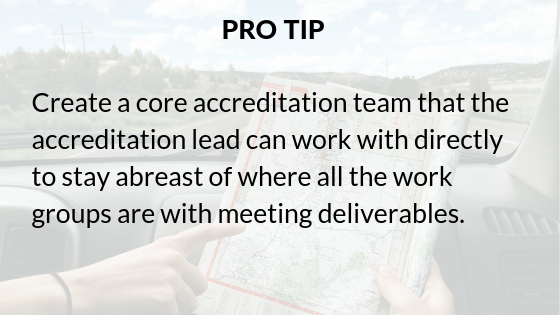
Responsibilities associated with stages of accreditation process
There are six stages in the accreditation process, each with different responsibilities. Below are some salient tasks for which the organization is responsible.
Application & agreement
The application and agreement phase of the process is an opportunity for the organization to assess the cost of accreditation and explore the service standard sections that may be relevant to the programs provided. Once the organization has decided to pursue COA accreditation, the accreditation agreement is signed and the work begins.
Intake
Think of the intake stage as COA’s opportunity to acquire information from the organization on all your programs and locations in which they operate. When highlighting the scope of services at each program, be concise. COA uses this information to determine the appropriate service standard for each program. Do not spend many months in this stage of the process – it will prolong the assignment of service standards. The organization’s Site Visit will not be scheduled until all program documentation has been submitted to COA.
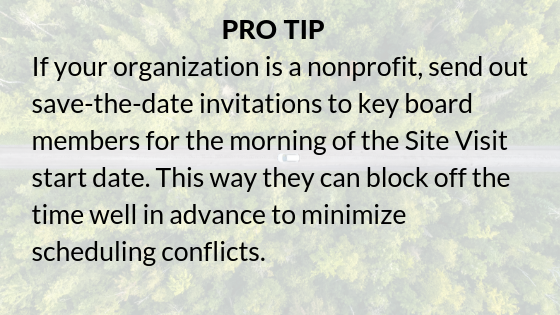
Self-Study
When the organization enters the self-study stage of the accreditation process, all standard sections have been assigned and the due dates for the Preliminary Self-Study and Self-Study have been scheduled, along with the start date for the Site Visit.
During this phase of the accreditation process, the organization should implement the structure for managing the standards review. Work groups should conduct an assessment of its current practices, policies and procedures against the COA standards. A self-assessment helps the organization to know where it needs to prioritize its time and resources.
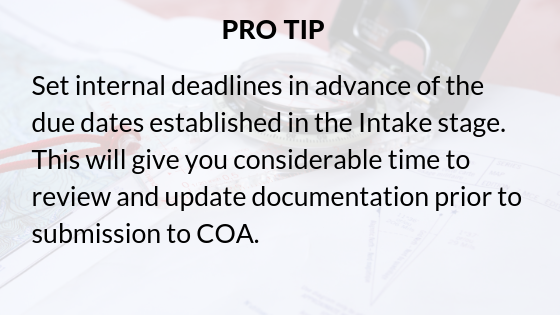
Site Visit
Once the Self-Study has been submitted, the accreditation work groups should begin compiling documentation to have available during the Site Visit. Reserve a meeting room for the Peer Review team to use while they are onsite for the duration of the Site Visit. All documentation should be clearly labelled by standard section, including the relevant core concept standard. The information the Peer Review team will evaluate can be available in paper or electronic format.
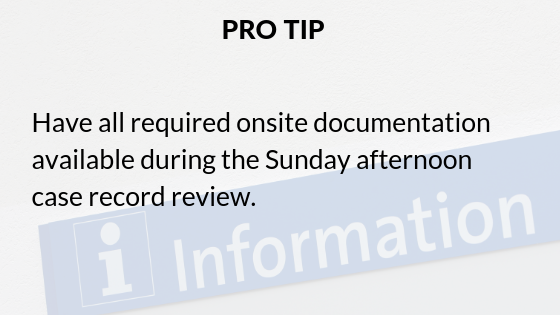
Building and sustaining momentum
If you are following the steps as listed, by now the “why” behind accreditation has already been established. An inventory of the strengths of staff has been conducted, and the process for managing the accreditation work is in place. Now the organization needs to formally roll out this significant initiative and keep staff engaged throughout the entire process.
Set a kick-off date
A kick-off event, such as an all-staff meeting, is a great way to launch the accreditation work. Use this time as an opportunity for the executive director to explain to staff why the organization is pursuing accreditation and why it is valuable. It is an opportunity to inform staff that pursuing accreditation can provide professional development and team building.

Themes and activities
Knowing the “why” behind the organization’s pursuit of accreditation may not be enough for some. For those who are charged with managing the accreditation process, consider ways to make different aspects of the work fun and exciting. Television shows, sports, movies, are all options that may be suitable to connect accreditation work groups. Visual display boards serve as a reminder and can foster healthy competition within the organization.

Final thoughts
The accreditation process can be overwhelming —there are many aspects that need to be managed. Hopefully, your creative juices are flowing with ways to make this organization-wide initiative manageable and fun. Remember, to get others involved, align the work with the strengths of staff and challenge the organization to always strive to be better.
Been through the accreditation process before? Share your thoughts on some things you wish you had known before you started the accreditation process. Recently completed the accreditation process? Let us know some of your pro tips that helped your organization through!
It is no secret that the Council on Accreditation (COA) believes in what we do. We promote best practices and help our organizations to implement them with the aim that clients across the social services field will get the best possible quality of care. By accrediting the entire organization, we ensure that everyone—from human resources to finances to support staff—is working together to carry out that mission.

This is the “why” of organizational accreditation for COA and our accreditees alike. We are all here to do good; following best practices helps us do good in the most effective way possible.
Improving service quality is the most important benefit of organizational accreditation. But from our experience, it is not the only benefit! Every time an organization completes the accreditation process, COA asks about its impact. Several themes have come out of our survey responses.
Organizational accreditation improves operations.
Whole-organization accreditation provides a framework for staff to look at how they fulfill their mission now and discover how they can do so better. The benefits along the way are multifold: more open communication, sound strategic plans, streamlined work systems, better risk management…the list goes on. When an organization looks at itself holistically, it can find the root of any problems and be better equipped to solve them.
94% of COA-accredited organizations agree that accreditation improves organizational learning and knowledge. 82% agree that it improves organizational capacity. COA accreditation has helped some organizations bring themselves back from the brink of bankruptcy; others have used it as a tool to position themselves to become leaders in the field.
Many have expressed that reaccreditation is not an end of itself, but a tool to help them achieve new heights of living their mission. COA is proud to help them do that.
Organizational accreditation boosts marketability.
Organizational accreditation is a professional, 3rd-party recognition that an organization meets the highest standard for both quality service delivery and administrative practices. The effort that an organization goes through to achieve accreditation proves just how much its staff cares about what they do.
This hard work helps organizations stand out among competitors and builds goodwill. 85% of our organizations agree that COA accreditation improves their organization’s marketability. 90% agree that it improves their relationship with external stakeholders. Clients and community alike are looking for signs of quality—accreditation gives them a big one.
Organizational accreditation helps secure funding.
Organizational accreditation verifies that an organization not only does quality work, but also has sound financial, administrative, operational, and oversight practices. This third-party verification can inspire the confidence funders need to support an organization as it continues to grow.
This can help in terms of government funding, as well. COA is recognized in over 300 instances in 50 U.S. states, the District of Columbia, Canada, and China. Our list of recognitions continues to grow, and with it the financial benefit to our accredited organizations. As of December 2018, 70% of our organizations agree that COA accreditation ensures funding.
Organizational accreditation can give staff a sense of fulfillment.
Accreditation encourages organizations to look at themselves frankly and work toward continuous quality improvement. This can allow staff to take a break from their daily grind and appreciate the big picture of their impact. Organizational accreditation also facilitates transparency and open communication, which can increase trust and the feeling that everyone is working as part of one team. Finally, the quest for quality improvement provides staff with new professional opportunities, allowing them to lead the charge toward a brighter future for those they serve.
Almost three quarters of COA-accredited organizations agree that accreditation improves workforce engagement, and over half agree that it improves staff retention. Many of our organizations describe how empowering it is to see the change in mindset that accreditation can bring.
Organizational accreditation holds the team to its goals.
As anyone with a broken New Year’s resolution knows, it is easy to put great plans in place and never carry them out. Accreditation (and reaccreditation!) forces organizations to follow through with those great plans, holding them accountable to be the best they can be.
94% of COA-accredited organizations agree that our whole-organization accreditation improves transparency and accountability. Through it, staff become not only accountable to their clients and stakeholders, but to themselves.
Time and time again, accreditation has proved transformative for our organizations, supporting their mission and allowing them to provide clients with the quality service they deserve. COA is grateful and humbled to be a part of this important process.
Have you experienced other accreditation benefits not listed here? Share them with us in the comments!
SOURCE: All statistics are pulled from 2018 survey data from organizations accredited by the Council on Accreditation (COA).
Accreditation is a journey. One with a clear destination, but a less defined path. There are mile markers along the way; however, there isn’t necessarily one straight, easy road to the finish line. Is there a recommended route? Are there any anticipated hurdles? If you are tasked with leading the accreditation process for your organization, you may not know where to start. This is where COA’s Accreditation Coordinators come in.
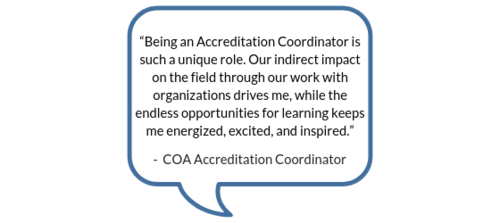
Every organization seeking COA accreditation is assigned an Accreditation Coordinator, a COA staff member that serves as a single point-of-contact throughout the accreditation journey. The role of the Accreditation Coordinator is unique to COA’s facilitative accreditation process. They work closely with the organization’s designated single point-of-contact, which COA refers to as the Primary Contact. Through this partnership, an organization obtains the support they need to navigate the road ahead.
Roles and responsibilities
Accreditation Coordinator
An Accreditation Coordinator works concurrently with a number of organizations. Their caseload can vary as well as the needs of each organization. The coordinators can also specialize in distinct accreditation programs or service types (Financial Education and Counseling, Employee Assistance Programs, Opioid Treatment Providers, etc.). Communication is a key element to this role. They’re responsible for answering questions, providing feedback on submitted documentation, and referring organizations to training and resources. Whether it’s to discuss specific documentation, standards, practices, or policies, they’re available on a daily basis to address inquiries from organizations. And because each organization comes with unique questions and circumstances, researching program models and administrative practices is also part of the work.

While the day-to-day routine of an Accreditation Coordinator involves providing tailored support to organizations, it is also valuable to note the role’s limitations. Accreditation Coordinators are not consultants and do not provide consultation to organizations. They can help Primary Contacts interpret the standards and answer questions, but are unable to dictate how implementation will look on the ground. Organizations are responsible for the application of the standards. And while they review and provide feedback on select pieces of evidence, specifically six key documents referred to as the Preliminary Self-Study (PSS), it is not within their role to review the entire Self-Study (aka all of the evidence that is required based on the assigned standards). The Site Review Team assesses the Self-Study prior to the Site Visit and will provide the ratings after conducting the on-site review.
Primary Contact
The Primary Contact is COA’s champion at the organization level and is in charge of spearheading the accreditation process. In this role, they’re responsible for engaging organization staff in all things COA. While the Primary Contact is the single point-of-contact, accreditation is by no means a one-person job. Accreditation is a huge team effort, from pulling together Self-Study evidence to preparing for the Site Visit, and the Primary Contact is the team captain. It’s no coincidence that we have repeatedly heard the role compared to “herding cats”!
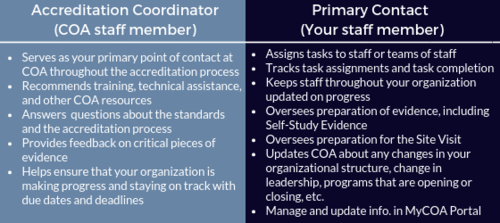
Exploring the relationship between the Accreditation Coordinator and the Primary Contact
COA’s mission is to partner with human service organizations worldwide to improve service delivery outcomes by developing, applying, and promoting accreditation standards. The relationship between the Accreditation Coordinator and the Primary Contact brings that partnership to life. The two work together throughout the accreditation process, from start (the intake call) to finish (the notification of accreditation). They’re there to kick off the expedition, advise you of the twists and turns, help navigate roadblocks, and ultimately make sure your organization hits all the necessary milestones en route to the final destination. Along the way, Primary Contacts should provide the Accreditation Coordinator with updates on their progress, highlighting successes and challenges. That information helps COA gauge the organization’s strengths and needs and informs the provision of targeted supports.
Learning about the challenges of navigating the process is vital to COA. We want to know about the unexpected obstacles in order to assist with readjusting your approach and preventing you from spiraling off course. For example, Performance and Quality Improvement (PQI) can be one major hurdle for organizations. As the Primary Contact it can feel daunting to try to implement a culture of PQI, especially if your organization doesn’t have the framework in place. As an Accreditation Coordinator, some of my favorite moments working with Primary Contacts have come from discussing the evolution of PQI. It could be talking through the development of a PQI committee (“Who should be on it?” “How often should they meet?”) or figuring out performance and outcome measures (“Can you explain outputs and outcomes again?” “What are some examples of operations and management performance measures?”). Standards and technical assistance inevitability guide the conversation, but it’s through this exchange that we learn how an organization goes about creating change. And isn’t that what it’s really all about? PQI helps an organization become stronger to better serve their clients and community.
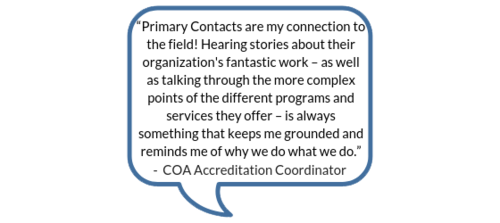
The relationship between the Accreditation Coordinator and Primary Contact is not one-size-fits-all. We are there to support in whatever capacity is most beneficial for the organization. For some this may take the form of structured monthly check-in calls, while others prefer Q&A exchanges over email. We recommend that organizations new to the accreditation process or new to the role of Primary Contact have more regular communication with their Accreditation Coordinator. Seasoned individuals may not need to rely on their coordinator as much; they remember the journey and have their path mapped out. Regardless of the frequency of contact, the door for communication is always open.
Tips for Primary Contacts
We know that serving as the Primary Contact is not an easy task. Often the work of accreditation is piled onto an already full plate. Here are some tips and tricks from COA’s team of Accreditation Coordinators:
- Use your Accreditation Coordinator as a resource. If you feel stumped or confused, don’t hesitate to reach out to your Accreditation Coordinator. Ask questions, it is what we are here for! That said, sometimes we get such excellent (and complex) questions that we need to consult with the team or the Standards Development department, which requires additional time. So it may take us time to get back to you with a response, but don’t worry; we will get back to you as soon as possible.
- Send us an email or schedule a call. The Accreditation Coordinator’s daily responsibilities are often collaborative – meeting frequently with organizations, our team, and other COA colleagues – which can sometimes impact our availability. We know Primary Contacts have busy schedules too. No one enjoys playing phone tag, it is best to schedule a call or send us an email. Our typical response time is 24 to 48 hours.
- Become friends with the MyCOA portal. We recommend that all Primary Contacts (and staff working actively on the process) participate in one of the regularly scheduled Intake Webinars in order to review all of the portal’s features and functionality. We don’t want to brag, but it is pretty cool! We encourage you to get familiar with the portal since this is where you will be completing the majority of the work. Check out the Step Pages, search for tools, and click all the buttons! Well not all the buttons.
- Attend a COA face-to-face training. There is no better way to familiarize yourself with all aspects of COA than attending either the in-person 2-day Intensive Accreditation Training or 1-day Performance and Quality Improvement Training. These in-person trainings provide Primary Contacts with an opportunity to learn from COA subject matter experts, meet COA staff and network with other organizations. We recognize this might not be a feasible option for all organizations due to limited resources and capacity. Therefore, we also offer a variety of complimentary live webinars and self-paced trainings covering similar curriculum. You can learn more and register through the Training Calendar.
- Don’t panic! This might be the most important tip on this entire list! The accreditation process is meant to be rigorous, but achievable. The goal is that you end the journey stronger than when you started. Change doesn’t happen overnight and it isn’t always easy, however, it is possible. The best advice for Primary Contacts is to not get overwhelmed; take the process one step at a time. Creating a work plan and communicating expectations to your team (don’t forget to enlist their help) is a good place to start. Have fun with it too! We have seen many primary contacts tap into their creative sides to invent games or enjoyable activities to get their team on board the COA train.
Training and resources
Want to know how to create a policy? We have a tip sheet for that! Want to know how to develop a strategic plan? We have a template (along with a self-paced training and blog post) for that! We’ve included just a few of the many resources that can help organizations on the road to achieving COA accreditation. We recommend exploring the full breadth of resources by accessing the tool search in the MyCOA Portal.
- Accreditation Learning Plan
- Getting Organized: Creating an Accreditation Workplan
- Preliminary Self-Study Fact Sheet
- Three-Part PQI Recorded Webinar Series
- PQI Tool Kit
- Preparing for the Site Visit
You are not alone
Many of us at COA have a social work (or social work adjacent) background, and the work we do to support Primary Contacts in their efforts to create change in their organizations, mirrors the work organizations do with their clients. We conduct an assessment. We create a service plan. We deliver supports and linkages to necessary resources. The makeup of our caseloads may be different, but we are all working towards a common goal – positive client outcomes and high quality services.
And as you learn from us, we learn from you. You are the change makers, advocating for those that you serve and making an impact on your communities. For many of us, the stories that you share and the work that you do are why we walk through the doors at COA. You are our direct connection to the field. Our collaboration allows us to gain a better understanding of service delivery and program models, as well as how the implementation of best practice looks on the ground for organizations of all shapes and sizes.
At the end of the day, an organization is ultimately responsible for their accreditation process, however, you are not alone on the journey. COA’s Accreditation Coordinators are there to support you and your team.
A big thank you to Stan Capela of Heartshare Human Services of New York for this guest post!
My name is Stan Capela and I have been a COA Peer Reviewer and Team Leader since 1996. By the end of April, I will have completed 112 Site Visits. At the glorious age of 65 after devoting 40 years to the field of social services, I’m beginning to reflect back on my journey. I want to share my experiences with you in honor of Volunteer Month.
Before I share my story let me give you a snapshot of a Volunteers numerous responsibilities. First you are assigned a Site Visit. I started as a Peer Reviewer, working with a team of colleagues to review an organization. Ten years ago, I became a Team Leader and gained more responsibilities such as; making contact with the organization, setting up travel for the Peer Review team, developing the Site Visit schedule, assigning standards sections to the Peer Reviewers, and leading the entrance and exit meetings where the team interacts with the organization. The latter gives the Peer Review team a chance to introduce themselves to the organization and provide information about how the review will take place.
Wait! I’m getting ahead of myself. The entire review process begins with a Self-Study submitted by the organization and reviewed prior to their Site Visit. When the review team arrives on-site most of their time is spent reviewing case records, policies and conducting interviews. By the time the exit meeting occurs, the Team Leader and review team are ready to provide an overview of the organization’s strengths and challenges. If you want to learn more about the Site Visit process then I recommend reading Recipe for Conducting Quality Accreditation Site Visits which I co-authored with Joe Frisino, a member of the COA Standards Development team, in New Directions for Evaluation.
The decision to become a COA Volunteer starts with the simple question, why? And traveling through my many memories leads me to that answer.
I remember on my first Site Visit I was eating dinner and mistakenly bit into an olive and broke my tooth. The executive director of the organization we were reviewing offered to have one of her board members who was also a dentist patch me up. I declined since I felt it would be a conflict of interest. After all it was just a cracked tooth.
Another significant memory is when I interviewed two girls, one 8 years old and the other 12 years old. They both had been abused and while talking with them they expressed how much they appreciated the staff helping them get through their pain.
There was also a memorable exit meeting where I remember commenting on the risk management minutes and asking who was responsible for creating them. A woman stood up and I complimented her on her work. That moment made the executive director stand up in that same meeting and say, “it goes to show you, we are all a part of a team dedicated to helping people in their time of need.” At the conclusion of that exit meeting the employee I engaged with beamed with pride as leadership walked over to say that they didn’t realize they were in the presence of such a star.
Once I was making the rounds and asked an employee to tell me a story that would make me remember the organization. He told me about Johnny and the mailbox. Basically, it was an individual with developmental disabilities who lived in a group home. One of his goals was to get the mail and distribute it. One day he went outside to the mailbox and found a baby inside. Johnny being trained properly brought the baby inside and gave it to the site manager. Many years later there was a knock on the door. The site manager opened the door and saw a very professional looking woman who asked for Johnny. The site manager said Johnny passed away a few years ago. The woman said I was the baby and wanted to thank him.
I remember another time that I was scheduled to meet with a client during a Site Visit. The client was transgender. During the interview the client expressed appreciation for how the staff treated her while she was transitioning. It felt good to hear how well the staff supported her and addressed her needs.
I have many more stories but these are just a few. So again, why? It’s about interacting with people and observing inspiring team work. When I conduct an entrance meeting as a Team Leader, I start by saying I know this is a lot of work, but we’ll get through it together. You should look at this Site Visit as an opportunity to invite people into your home and share your world with them. I try to get the point across that we are a family of helpers who have dedicated our lives to helping people in need and going through the accreditation process provides an opportunity to affirm what we do.
It’s very easy for me to answer the question why become a COA Volunteer after all these experience in these roles. My time as a Volunteer has made me feel like the richest person on the face of this earth. Again, why? Simple, I have decided to help people in my work at HeartShare Human Services of New York and in these roles at COA. In all my roles I’m able to make sure we all strive to meet the highest standards to reaffirm that the work we do meets the needs of the people we serve.
The views, information and opinions expressed herein are those of the author; they do not necessarily reflect those of the Council on Accreditation (COA). COA invites guest authors to contribute to the COA blog due to COA’s confidence in their knowledge on the subject matter and their expertise in their chosen field.
Stan Capela
Stan Capela spent 40 years in the field of program evaluation working the first ten at Catholic Charities for the Diocese of Brooklyn and Queens and the last 30 at HeartShare Human Services of New York formally known as Catholic Guardian Society of Brooklyn and Queens. During his time there he has had the opportunity to do a wide range of program evaluation, staff development workshops and presentations at various conferences such as American Evaluation Association, Canadian Evaluation Society, American Sociological Association, and Society for Applied Sociology to name a few. In addition, he participated on a variety of committees that played a role in developing a competency based child welfare training program known as the New York City Training Consortium. The program is overseen by the Council of Family and Child Caring Agencies. Finally, Stan participated on an internal committee at his current organization that developed a management training program that was the recipient of the COA Innovative Practice Award in 2012.


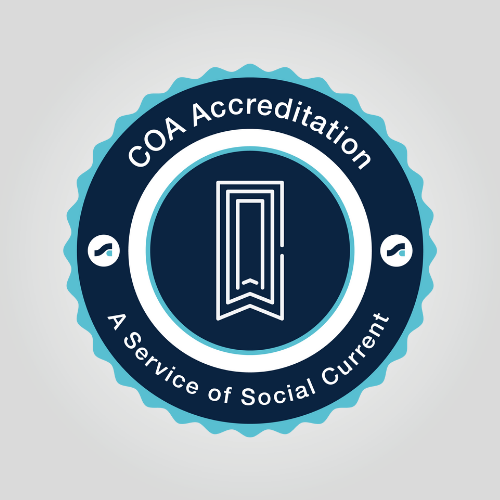
!["We have really enjoyed the fact that we are united by the power [of] COA accreditation and by sharing our common mission [of] providing children and families, in a contexual and in a multicultural approach, with the best." -Jorge Alberto Acosta, Founder of Nuevo Amanecer Latino Children's Services](https://static1.squarespace.com/static/5817757515d5dbcebad2b0bc/t/5c758d43f9619ac702a6edb4/1551207752285/Copy+of+Benefits+of+Accreditation+Pull+Quotes+%285%29.png?format=1000w)
